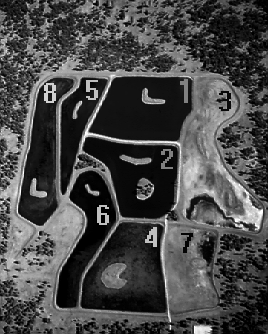By: Curtis R. Holiday and Memi V. Heeder. 1995.
Abstract: Fifteen mallard (Anas platyrhynchos) nests were found between June 1 and August 4, 1995, in the Kachina Wetlands, Flagstaff, Arizona. Seven nests successfully fledged and eight failed, with an overall success rate of 18.3%. Buck brush cover was associated with the highest nest success, but the mallards placed more nests among boulders and quack grass (Agropyron repens). Raccoons (Procyon lotor) and skunks (Mephitis mephitis) were responsible for most of the nest destruction. Nest success on the islands of the Kachina Wetlands during this period was slightly more than twice as high as the 9.0% nest success in the Union Slough National Wildlife Refuge, Iowa (Fleskes & Klaas 1991).
Introduction: The objective of the study was to evaluate the nesting success of mallards at the Kachina Wetlands south of Flagstaff, Arizona. Nesting cover and predator impact were examined as potential factors affecting nesting success. Results would be compared with a study on nesting success in the Union Slough National Wildlife Refuge, Iowa (Fleskes & Klaas 1991).
 Methods: All the islands at Kachina Wetlands are small and those in Ponds 1-6 and 8 were surveyed at least once a week from June 1, 1995 through August 4, 1995 by pacing each island. The eggs in each nest were counted and the number of eggs that hatched from each nest were recorded. The type of nest cover was also recorded, whether vegetation, boulders, or large rocks. Nests failed either because they were abandoned or because of predation.
Methods: All the islands at Kachina Wetlands are small and those in Ponds 1-6 and 8 were surveyed at least once a week from June 1, 1995 through August 4, 1995 by pacing each island. The eggs in each nest were counted and the number of eggs that hatched from each nest were recorded. The type of nest cover was also recorded, whether vegetation, boulders, or large rocks. Nests failed either because they were abandoned or because of predation.The condition of a nest indicated which predator was responsible for nest failure (Fleskes & Klaas 1991). The red-tailed hawk (Buteo jamaicensis) leaves crushed eggs in the nest with feathers of the female mallard. Grackles (Quiscalus quiscula), ravens (Corvus corax) and American crows (Corvus brachyrynchos) peck holes in the eggs and leave the empty shells. Striped skunks (Mephitis mephitis) and raccoons (Procyon lotor) leave crushed egg shells and remove some eggs. Any part of a female mallard carcass in the vicinity of the nest indicates a coyote (Canis latrans).
The Mayfield (1975) method was used to calculate nest success.
 Results: From June 1 through August 4, 1995, 15 mallard nests were surveyed. Nest cover included quack grass, buck brush, ponderosa pine, and boulders or large rock piles. Seven nests were successful and eight nests failed, resulting in a nest success of 18.3%.
Results: From June 1 through August 4, 1995, 15 mallard nests were surveyed. Nest cover included quack grass, buck brush, ponderosa pine, and boulders or large rock piles. Seven nests were successful and eight nests failed, resulting in a nest success of 18.3%.Successful nests were on islands in: Pond 2 South, hatching 8 of 9, 10 of 10, and 11 of 12 eggs; Pond 6, hatching 6 of 7 eggs; Pond 4, hatching 7 of 7, 9 of 10, and 7 of 7. Successful nests hatched 92% of the eggs. There were 107 eggs laid in all nests and 54% of those hatched.
Failed nests included two that were abandoned by the female. Predators destroyed six nests: 4 by skunks or raccoons; 1 by grackles or crows; and 1 by a coyote.
Discussion: Nesting success was high on some islands and low on others. The islands with multiple nests had high nesting success. Although the area on these islands was not measured, the number of nests suggests that these islands were larger than those with few and more unsuccessful nests.
Buck brush is a small but dense bush that confers good cover for both a nest and the female. The quality and quantity of nest cover varied among islands and could have contributed to better nest success on some of them.
Since raccoons and skunks were the greatest cause of nest failure, the depth of water in the ponds and the distance between islands and the berms could have combined to protect nests on some islands. On the other hand, every island had at least one nest fail.
Forty-nine ducklings hatched during this period, which is a 99% increase in the duck population, counting 2 parents for each of the 15 nests. One mallard nest found that was not on an island was unsuccessful. Although it seems that islands would enhance nest success, the sample size of the one nest not on an island is too small to test that hypothesis. On the other hand, the nesting success at the Kachina Wetlands in this season was slightly more than twice that of a study of nesting success at the Union Slough National Wildlife Refuge, Iowa (Fleskes & Klaas 1991). While the mallards achieve a good start with the number of ducklings produced, survivorship during the juvenile stage needs to be taken into account for final judgment for replenishment.
Literature Cited:
Fleskes, J. P., and E. E. Klaas. 1991. Dabbling duck recruitment in relation to habitat and predators at Union Slough National Wildlife Refuge, Iowa: U.S. Fish and Wildlife Service, Fish and Wildlife Technical Report 32, 19 p.
Mayfield, Harold F. 1975. Suggestions for Calculating Nest Success. Wilson Bulletin 87:456-466.